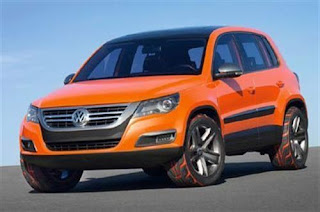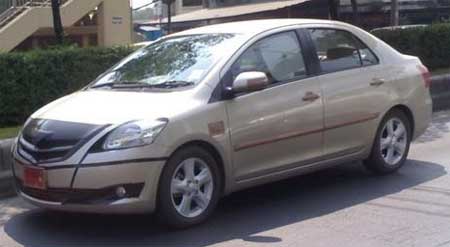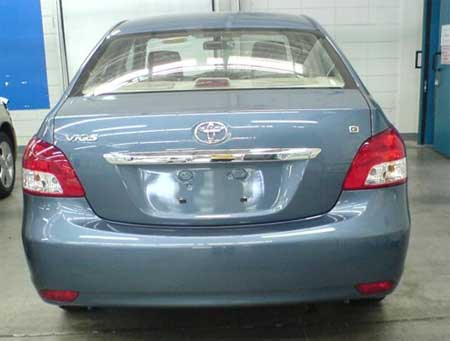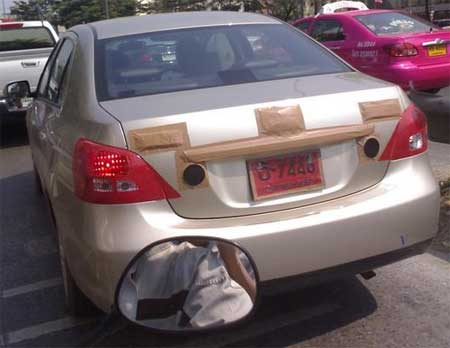PAST
2000 Honda Insight
 When Honda released the Insight in 1999, it was the first production hybrid electric car available in the U.S. For five consecutive years, it earned the highest combined EPA rating for fuel economy in a passenger car at 60/66 mpg (city/highway). The gas-electric combination along with an aerodynamic, lightweight aluminum chassis allowed the Insight to be the most fuel efficient car. As the first Honda hybrid car, the Insight was created to obtain the best possible mileage, therefore it is a small, lightweight two-seater with a small, high-efficiency gasoline engine. The concept of the Honda Insight hybrid and the reasons for its development began because of Honda's philosophy that motor vehicles should function in harmony with the environment. For over 25 years, this automaker has been researching high-mileage, low-emission vehicles. Among Honda hybrid cars, the earlier Civics met pollution standards and Honda has been testing various alternative sources of power-from all electric cars to solar-powered vehicles. The first version of the Honda Insight hybrid, the JV-X concept car, was introduced in 1997 in Tokyo and Los Angeles. The next edition, the VV concept car, was presented in 1999 in Detroit. Perhaps due to its size, the Honda Insight hybrid has not sold well against the Honda Civic hybrid and the Toyota Prius, which have four doors and obtain nearly as good mileage for comparable cost.
When Honda released the Insight in 1999, it was the first production hybrid electric car available in the U.S. For five consecutive years, it earned the highest combined EPA rating for fuel economy in a passenger car at 60/66 mpg (city/highway). The gas-electric combination along with an aerodynamic, lightweight aluminum chassis allowed the Insight to be the most fuel efficient car. As the first Honda hybrid car, the Insight was created to obtain the best possible mileage, therefore it is a small, lightweight two-seater with a small, high-efficiency gasoline engine. The concept of the Honda Insight hybrid and the reasons for its development began because of Honda's philosophy that motor vehicles should function in harmony with the environment. For over 25 years, this automaker has been researching high-mileage, low-emission vehicles. Among Honda hybrid cars, the earlier Civics met pollution standards and Honda has been testing various alternative sources of power-from all electric cars to solar-powered vehicles. The first version of the Honda Insight hybrid, the JV-X concept car, was introduced in 1997 in Tokyo and Los Angeles. The next edition, the VV concept car, was presented in 1999 in Detroit. Perhaps due to its size, the Honda Insight hybrid has not sold well against the Honda Civic hybrid and the Toyota Prius, which have four doors and obtain nearly as good mileage for comparable cost.
PRESENT
2004 Toyota Prius
With gas prices at all time highs and pollution levels rising as fast, an increasing number of motorists are demanding the kind of technology the Toyota Prius offers. With an EPA rating of 60/51 mpg (city/highway), the Prius is at the top of fuel-efficient cars in the mid-size sedan class.  This Toyota hybrid car's emissions are the lowest of any conventional or hybrid car being sold, and its price is in line with other cars of its size. As the world's first mass-produced hybrid electric car, the Prius meets the California Super Ultra Low Emission rating, reducing CO2 emissions up to 50% and regulated tailpipe emissions by up to 90% over conventional vehicles. "When the 2005 Prius arrives in dealerships this fall it will exceed all expectations, marking the arrival of hybrid technology into the mainstream consumer mindset," remarked Don Esmond, senior vice president and general manager, Toyota Division. "Furthermore, the debut of the Toyota Hybrid Synergy Drive system will represent a major breakthrough in global-friendly powertrain technology." The 2005 Prius starts at $21,275, up about $1,000 from the 2004. Popular with Hollywood celebrities from Cameron Diaz to Rob Reiner, this Toyota hybrid car is the most successful hybrid to date. Toyota has sold more than 120,000 Prius models in the U.S. through the end of 2004. Monthly sales have been averaging 10,000 units in 2005. Winner of the 2004 Motor Trend Car of the Year and Consumer Reports Best Green Car, statistics for this Toyota hybrid car are backed by the laboratory testing done by the Department of Energy (DOE) and the U.S. Environmental Protection Agency (EPA). With the success of the first Toyota hybrid car, this carmaker entered the SUV hybrid car market with the release of the Toyota Highlander hybrid and Lexus SUV hybrid in early 2005. And the Lexus SUV hybrid is poised for a late 2004, early 2005 launch.
This Toyota hybrid car's emissions are the lowest of any conventional or hybrid car being sold, and its price is in line with other cars of its size. As the world's first mass-produced hybrid electric car, the Prius meets the California Super Ultra Low Emission rating, reducing CO2 emissions up to 50% and regulated tailpipe emissions by up to 90% over conventional vehicles. "When the 2005 Prius arrives in dealerships this fall it will exceed all expectations, marking the arrival of hybrid technology into the mainstream consumer mindset," remarked Don Esmond, senior vice president and general manager, Toyota Division. "Furthermore, the debut of the Toyota Hybrid Synergy Drive system will represent a major breakthrough in global-friendly powertrain technology." The 2005 Prius starts at $21,275, up about $1,000 from the 2004. Popular with Hollywood celebrities from Cameron Diaz to Rob Reiner, this Toyota hybrid car is the most successful hybrid to date. Toyota has sold more than 120,000 Prius models in the U.S. through the end of 2004. Monthly sales have been averaging 10,000 units in 2005. Winner of the 2004 Motor Trend Car of the Year and Consumer Reports Best Green Car, statistics for this Toyota hybrid car are backed by the laboratory testing done by the Department of Energy (DOE) and the U.S. Environmental Protection Agency (EPA). With the success of the first Toyota hybrid car, this carmaker entered the SUV hybrid car market with the release of the Toyota Highlander hybrid and Lexus SUV hybrid in early 2005. And the Lexus SUV hybrid is poised for a late 2004, early 2005 launch.
2004 Honda Civic Hybrid
In 2002, Honda launched the Civic Hybrid as a direct competitor to the Toyota Prius.  It looks like a Civic, drives like a Civic, but at an average of 48 mpg, the Honda Civic hybrid gets almost 30% higher mileage than its non-hybrid counterpart and all the performance quality Honda is known for. On the outside it appears to be just like a conventional Civic four-door, 5-passenger sedan in size and design, but under the hood, however, is where the differences exist. A cover beneath the engine and rear floor improves aerodynamics and subsequently fuel economy, and a cable runs from the transmission housing to connect the electric motor stashed between the transmission and the gas engine to the battery control at the rear. The Honda Civic hybrid's electric components are more compact than the Honda Insight hybrid's and are lodged between the back of the rear seat at the front of the trunk, accessible through a trunk panel. The 2004 Honda Civic hybrid was named to Edmunds.com's list of the "Top 10 Most Fuel Efficient Cars for 2004." And IntelliChoice®, a leading automotive information company, named the Honda Civic hybrid the Best Overall Value for a Compact Over $17,000. "Putting hybrid technology into our most popular model is a further indication of Honda's commitment to hybrid technology and our confidence that consumers are ready for more hybrid models," said Tom Elliott, Executive VP, American Honda Motor Co., Inc. Honda hybrid cars remains at the forefront with the release of the Accord hybrid in late 2004 and the newly upgraded 2006 Honda Civic Hybrid.
It looks like a Civic, drives like a Civic, but at an average of 48 mpg, the Honda Civic hybrid gets almost 30% higher mileage than its non-hybrid counterpart and all the performance quality Honda is known for. On the outside it appears to be just like a conventional Civic four-door, 5-passenger sedan in size and design, but under the hood, however, is where the differences exist. A cover beneath the engine and rear floor improves aerodynamics and subsequently fuel economy, and a cable runs from the transmission housing to connect the electric motor stashed between the transmission and the gas engine to the battery control at the rear. The Honda Civic hybrid's electric components are more compact than the Honda Insight hybrid's and are lodged between the back of the rear seat at the front of the trunk, accessible through a trunk panel. The 2004 Honda Civic hybrid was named to Edmunds.com's list of the "Top 10 Most Fuel Efficient Cars for 2004." And IntelliChoice®, a leading automotive information company, named the Honda Civic hybrid the Best Overall Value for a Compact Over $17,000. "Putting hybrid technology into our most popular model is a further indication of Honda's commitment to hybrid technology and our confidence that consumers are ready for more hybrid models," said Tom Elliott, Executive VP, American Honda Motor Co., Inc. Honda hybrid cars remains at the forefront with the release of the Accord hybrid in late 2004 and the newly upgraded 2006 Honda Civic Hybrid.
FUTURE
2005 Ford Escape Hybrid/GMC Hybrid trucks
 The next few years promise an onslaught of new hybrid vehicles. The most exciting of these are the hybrid SUVs and hybrid trucks. Among the SUV hybrids are the Toyota Highlander, Saturn VUE SUV, the Lexus RX400H and the Ford Escape hybrid SUV. In the works also are the Dodge Ram, Chevy Silverado and GM Sierra pickups. The timing is not concrete, but AllAboutHybridCars.com's Web site and newsletter will keep you informed as new models are released.
The next few years promise an onslaught of new hybrid vehicles. The most exciting of these are the hybrid SUVs and hybrid trucks. Among the SUV hybrids are the Toyota Highlander, Saturn VUE SUV, the Lexus RX400H and the Ford Escape hybrid SUV. In the works also are the Dodge Ram, Chevy Silverado and GM Sierra pickups. The timing is not concrete, but AllAboutHybridCars.com's Web site and newsletter will keep you informed as new models are released.
The Chevy Silverado hybrid pickup is positioned to be the first full-size hybrid pickup to enter the market, with an EPA rating of 18/20 mpg (city/highway) in the 2WD and 17/19 mpg in the 4WD. This is estimated to be 5-13% better mileage than the non-hybrid pickup.
The GMC Sierra hybrid pickup, which may fight for first place against the Silverado as the first hybrid pickup, has the same EPA ratings as the Chevy Silverado hybrid and also will be available in 2WD and 4WD.
Ford, the first U.S. automaker to launch a hybrid, released the 2005 Ford Escape hybrid SUV in late 2004. This fuel-efficient car has an EPA rating of 36/31 mpg (city/highway) and has as much power as the non-hybrid, which averages 25 mpg. The first full-hybrid SUV to hit the market, Ford's hybrid SUV is priced around $26,970 for front-wheel drive and from $28,595 for four-wheel drive, which will have a slightly lower mileage rating (the non-hybrids start at $19,855). "The demand is high and it's growing," stated Angela Coletti, Ford's spokesperson for the vehicle line. She also said the automaker plans to sell around 20,000 Ford hybrid SUVs the first year and will increase output as the market demands it.




 This Toyota hybrid car's emissions are the lowest of any conventional or hybrid car being sold, and its price is in line with other cars of its size. As the world's first mass-produced hybrid electric car, the Prius meets the California Super Ultra Low Emission rating, reducing CO2 emissions up to 50% and regulated tailpipe emissions by up to 90% over conventional vehicles. "When the 2005 Prius arrives in dealerships this fall it will exceed all expectations, marking the arrival of hybrid technology into the mainstream consumer mindset," remarked Don Esmond, senior vice president and general manager, Toyota Division. "Furthermore, the debut of the Toyota Hybrid Synergy Drive system will represent a major breakthrough in global-friendly powertrain technology." The 2005 Prius starts at $21,275, up about $1,000 from the 2004. Popular with Hollywood celebrities from Cameron Diaz to Rob Reiner, this Toyota hybrid car is the most successful hybrid to date. Toyota has sold more than 120,000 Prius models in the U.S. through the end of 2004. Monthly sales have been averaging 10,000 units in 2005. Winner of the 2004 Motor Trend Car of the Year and Consumer Reports Best Green Car, statistics for this Toyota hybrid car are backed by the laboratory testing done by the Department of Energy (DOE) and the U.S. Environmental Protection Agency (EPA). With the success of the first Toyota hybrid car, this carmaker entered the SUV hybrid car market with the release of the Toyota Highlander hybrid and Lexus SUV hybrid in early 2005. And the Lexus SUV hybrid is poised for a late 2004, early 2005 launch.
This Toyota hybrid car's emissions are the lowest of any conventional or hybrid car being sold, and its price is in line with other cars of its size. As the world's first mass-produced hybrid electric car, the Prius meets the California Super Ultra Low Emission rating, reducing CO2 emissions up to 50% and regulated tailpipe emissions by up to 90% over conventional vehicles. "When the 2005 Prius arrives in dealerships this fall it will exceed all expectations, marking the arrival of hybrid technology into the mainstream consumer mindset," remarked Don Esmond, senior vice president and general manager, Toyota Division. "Furthermore, the debut of the Toyota Hybrid Synergy Drive system will represent a major breakthrough in global-friendly powertrain technology." The 2005 Prius starts at $21,275, up about $1,000 from the 2004. Popular with Hollywood celebrities from Cameron Diaz to Rob Reiner, this Toyota hybrid car is the most successful hybrid to date. Toyota has sold more than 120,000 Prius models in the U.S. through the end of 2004. Monthly sales have been averaging 10,000 units in 2005. Winner of the 2004 Motor Trend Car of the Year and Consumer Reports Best Green Car, statistics for this Toyota hybrid car are backed by the laboratory testing done by the Department of Energy (DOE) and the U.S. Environmental Protection Agency (EPA). With the success of the first Toyota hybrid car, this carmaker entered the SUV hybrid car market with the release of the Toyota Highlander hybrid and Lexus SUV hybrid in early 2005. And the Lexus SUV hybrid is poised for a late 2004, early 2005 launch.
 The next few years promise an onslaught of new hybrid vehicles. The most exciting of these are the hybrid SUVs and hybrid trucks. Among the SUV hybrids are the Toyota Highlander, Saturn VUE SUV, the Lexus RX400H and the Ford Escape hybrid SUV. In the works also are the Dodge Ram, Chevy Silverado and GM Sierra pickups. The timing is not concrete, but AllAboutHybridCars.com's Web site and newsletter will keep you informed as new models are released.
The next few years promise an onslaught of new hybrid vehicles. The most exciting of these are the hybrid SUVs and hybrid trucks. Among the SUV hybrids are the Toyota Highlander, Saturn VUE SUV, the Lexus RX400H and the Ford Escape hybrid SUV. In the works also are the Dodge Ram, Chevy Silverado and GM Sierra pickups. The timing is not concrete, but AllAboutHybridCars.com's Web site and newsletter will keep you informed as new models are released. 








































